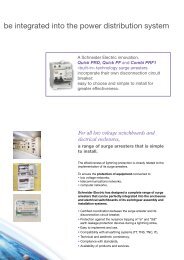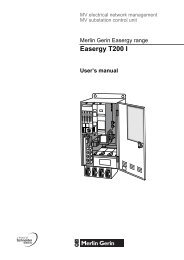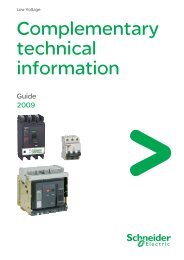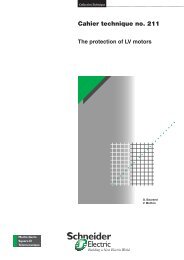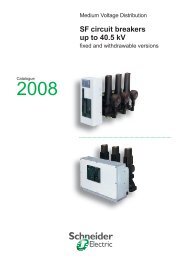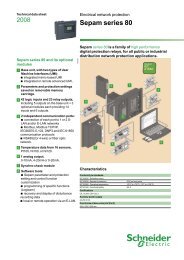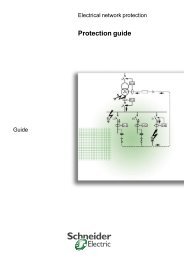Load control to balance limited or intermittent ... - Schneider Electric
Load control to balance limited or intermittent ... - Schneider Electric
Load control to balance limited or intermittent ... - Schneider Electric
Create successful ePaper yourself
Turn your PDF publications into a flip-book with our unique Google optimized e-Paper software.
<strong>Schneider</strong> <strong>Electric</strong> 2007 - Conferences publications<br />
C I R E D <br />
<br />
<br />
<br />
Adaptive consumption alg<strong>or</strong>ithm with preponing<br />
and postponing<br />
The second alg<strong>or</strong>ithm was tested in the same simulation<br />
conditions as the first. The results are presented in Figure 7.<br />
The graph shows that available energy is used in best way.<br />
Only a small amount of energy is lost <strong>or</strong> s<strong>to</strong>red. The s<strong>to</strong>red<br />
<strong>or</strong> lost production curve is null nearly the entire day, except<br />
during the night, when consumption falls.<br />
As mentioned bef<strong>or</strong>e, production and consumption peaks do<br />
not coincide, so some loads are supplied in advance, others<br />
are delayed. In consequence, even if the delivery plan is not<br />
optimal at every step, the <strong>to</strong>tal delivery is satisfying.<br />
The general result of this improved alg<strong>or</strong>ithm is that<br />
consumption is adapted <strong>to</strong> production almost continually.<br />
Figure 5:production and <strong>to</strong>tal consumption f<strong>or</strong> the<br />
simulations<br />
Figure 6:supply and s<strong>to</strong>red <strong>or</strong> lost production f<strong>or</strong> the basic<br />
alg<strong>or</strong>ithm<br />
Figure 7:supply and s<strong>to</strong>red <strong>or</strong> lost production f<strong>or</strong> the<br />
improved alg<strong>or</strong>ithm<br />
Comparison between the two versions<br />
Figure 8allows comparing the two solutions of load <strong>control</strong>,<br />
in relation <strong>to</strong> consumption on the left side, and <strong>to</strong><br />
production on the right side. Results of this comparison are<br />
m<strong>or</strong>e qualitative than quantitative, but show which potential<br />
benefits are represented by preponing and postponing load<br />
<strong>control</strong>.<br />
As it has been said earlier, the conditions are the same f<strong>or</strong><br />
both simulations; there is a 6% deficit of energy.<br />
The basic alg<strong>or</strong>ithm satisfies only three quarters of the<br />
demand, although nearly 20% of the production is lost,<br />
s<strong>to</strong>red <strong>or</strong> fed back in<strong>to</strong> the netw<strong>or</strong>k.<br />
The improved version allows <strong>to</strong> satisfy m<strong>or</strong>e than 90% of<br />
the demand, and <strong>to</strong> use almost all the production (only 3%<br />
is lost).<br />
Results are promising in using load <strong>control</strong> <strong>to</strong> counteract<br />
uncertainty of <strong>limited</strong> <strong>or</strong> <strong>intermittent</strong> productions.<br />
Figure 8: comparison between the two alg<strong>or</strong>ithm versions<br />
CONCLUSION<br />
This w<strong>or</strong>k illustrated how in the future load <strong>control</strong> could<br />
help <strong>to</strong> ensure Production/Consumption <strong>balance</strong>, in <strong>or</strong>der <strong>to</strong><br />
mitigate production uncertainty, in case of <strong>limited</strong> <strong>or</strong><br />
<strong>intermittent</strong> production. A classification has been first<br />
presented, introducing notions such as “<strong>control</strong>lable loads”,<br />
“pre”, “post-shiftable loads” <strong>or</strong> “critical loads”. Then, <strong>to</strong><br />
describe these loads, mathematical models have been<br />
recalled. Finally, two versions of an adaptive consumption<br />
alg<strong>or</strong>ithm have been implemented in Matlab. They aim <strong>to</strong><br />
ensure production/consumption <strong>balance</strong> by <strong>control</strong>ling<br />
loads. The second is an improved version of the first one,<br />
because it tries <strong>to</strong> use all the available production at each<br />
time step. To ensure this <strong>balance</strong> adequate equipment f<strong>or</strong><br />
measurement, communication, and <strong>control</strong> must be<br />
implemented. Results of these alg<strong>or</strong>ithms show that load<br />
shedding could help efficiency f<strong>or</strong> production/consumption<br />
<strong>balance</strong>. M<strong>or</strong>eover, by <strong>control</strong>ling specifics charges, it will<br />
be possible <strong>to</strong> provide some kind of load reserve, and<br />
consequently <strong>to</strong> help <strong>to</strong> maintain distribution netw<strong>or</strong>k<br />
reliable and safe, even under m<strong>or</strong>e and m<strong>or</strong>e critical<br />
operating constraints related <strong>to</strong> grid evolutions.<br />
REFERENCES<br />
[1] CRISP project, http://www.ecn.nl/crisp/<br />
[2] Oh H., Moholkar A., Douglas S., Klinkhach<strong>or</strong>n P., January 2006,<br />
System Reliability and Price Responsiveness of Residential <strong>Load</strong>s,<br />
West Virginia University Advanced Power& <strong>Electric</strong>ity Research<br />
Center (APERC).<br />
[3] Kirby B. and Hirst E., February 10, 2003 , Technical Issues Related<br />
To Retail-<strong>Load</strong> Provision of Ancillary Services, New England<br />
Demand Responsive Initiative<br />
[4] Calif<strong>or</strong>nia Energy Commission prepared by Architectural Energy<br />
C<strong>or</strong>p<strong>or</strong>ationand Battelle Mem<strong>or</strong>ial Institue N<strong>or</strong>thwest Division,<br />
Oc<strong>to</strong>ber 2003, Final Rep<strong>or</strong>t Compilation f<strong>or</strong> Smart <strong>Load</strong> Control and<br />
Grid-Friendly Appliances.<br />
[5] Lighting Institute at Rensselaer Polytechic, Albany, 2003, NY,<br />
http//:lrc.rpi.edu/researchTopics/caseStudies/index.asp<br />
[6] Tayl<strong>or</strong> C.W., 1994,Power System Voltage Stability, Mc Graw-Hill,<br />
USA, 17-135<br />
[7] Louie K.W., 2004, A new approach <strong>to</strong> compose load devices in<br />
electric power systems, International Journal of Applied Science and<br />
Engineering, 197-210






